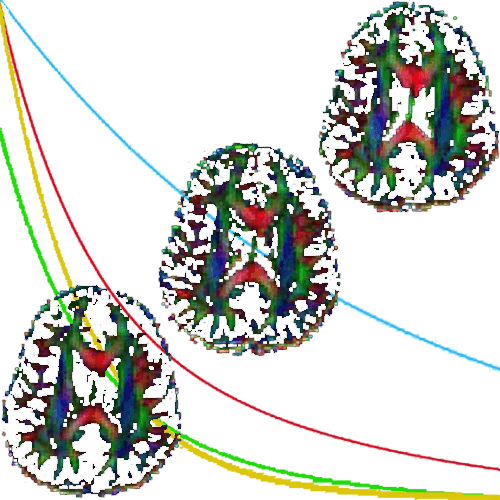Application
A diffusion model-free framework with echo time dependence for free-water elimination and brain tissue microstructure characterization.
Contributors
Miguel Molina-Romero1,2, Pedro A. Gómez1,2, Jonathan I. Sperl2, Michael Czisch3, Philipp G. Sämann3, Derek K. Jones4,5, Marion I. Menzel2, Bjoern H. Menze1,6
Estimated cost
Free
Progress
Stable release, GNU Lesser General Public License v3.0
Disentangling brain tissue compartments with blind source separation.
With blind source separation (BSS) one can separate microstructure tissue components from the diffusion MRI signal, characterize the volume fractions, and T2 maps of these compartments. Scanning a typical diffusion protocol for two echo times and feeding these data into this BSS algorithm corrects the diffusion signal for CSF contamination, generates FLAIR equivalent T2 maps of tissue, and CSF and tissue volume fraction maps. It is necessary that used diffusion protocol includes at least one non-diffusion-weighted volume, and the difference between echo times is 70 ms. Due to hardware restriction in clinical MR scanners this is only possible up to two tissue components.
This method does not model the compartmental diffusion behavior. It replaces the ILTs by a blind source separation (BSS) technique, reducing the minimum number of distinct echo times required to the number of compartments in the tissue, less than for regularized inverse Laplace transforms (ILTs) based methods. Other than the requirement to measure at more than one echo time, this framework is diffusion protocol-agnostic, and can be used in combination with any protocol of interest. This approach quantifies proton density, compartmental volume fractions, and transverse relaxation times. Importantly, it handles diffusion signals from each compartment independently, allowing for individual analyses, and thus performs CSF partial volume correction as a direct application.
Publications
Affiliations
1Department of Computer Science, Technical University of Munich, Garching, Germany
2GE Global Research Europe, Garching, Germany
3Max Planck Institute of Psychiatry, Munich, Germany
4CUBRIC, Cardiff University, Cardiff, UK
5School of Psychology, Faculty of Health Sciences, Australian Catholic University, Melbourne, Australia
6Institute for Advanced Study, Technical University of Munich, Garching, Germany


